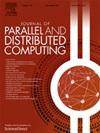面向梯度直方图描述符在群机器人嵌入式跟踪中的比较硬件实现
IF 3.4
3区 计算机科学
Q1 COMPUTER SCIENCE, THEORY & METHODS
引用次数: 0
摘要
定向梯度直方图(Histogram of Oriented Gradients, HOG)算法在图像处理中被广泛应用于检测、分类和跟踪等任务。然而,在内存有限、功耗低的计算平台(如移动机器人和无人机)上实现该算法时,会遇到一些挑战。本研究对HOG的三种创新硬件架构进行了深入的分析和实现,这些架构是专门为在移动机器人定位的背景下使用现场可编程门阵列(fpga)进行实时处理而设计的。这些体系结构的主要重点是简化涉及梯度大小和方向计算、直方图生成和归一化的处理操作。这些简化导致资源利用和能源消耗的减少。在Zynq 7020设备上进行的实验结果表明,在整个过程中相对误差值最小,与基于软件的解决方案相比,执行时间显著提高1000倍以上。本文章由计算机程序翻译,如有差异,请以英文原文为准。

A comparative hardware implementation of histogram of oriented gradients as a descriptor in embedded tracking of swarm robots
The Histogram of Oriented Gradients (HOG) algorithm is widely utilized in image processing for tasks such as detection, classification, and tracking. However, several challenges arise when implementing this algorithm on computing platforms with limited memory and low power consumption, such as mobile robots and drones. This work presents an in-depth analysis and implementation of three innovative hardware architectures for HOG, specifically designed for real-time processing using Field Programmable Gate Arrays (FPGAs) in the context of mobile robot localization. The primary focus of these architectures is to simplify the processing operations involved in gradient magnitude and orientation calculation, histogram generation, and normalization. These simplifications lead to a reduction in resource utilization and energy consumption. Experimental results conducted on a Zynq 7020 device demonstrated minimal relative error values throughout the entire process, along with a significant execution time improvement of over 1000 times when compared to the software-based solution.
求助全文
通过发布文献求助,成功后即可免费获取论文全文。
去求助
来源期刊

Journal of Parallel and Distributed Computing
工程技术-计算机:理论方法
CiteScore
10.30
自引率
2.60%
发文量
172
审稿时长
12 months
期刊介绍:
This international journal is directed to researchers, engineers, educators, managers, programmers, and users of computers who have particular interests in parallel processing and/or distributed computing.
The Journal of Parallel and Distributed Computing publishes original research papers and timely review articles on the theory, design, evaluation, and use of parallel and/or distributed computing systems. The journal also features special issues on these topics; again covering the full range from the design to the use of our targeted systems.
 求助内容:
求助内容: 应助结果提醒方式:
应助结果提醒方式:


